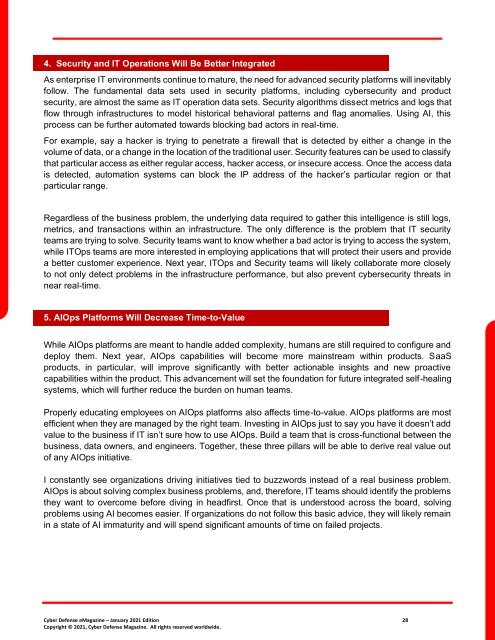Cyber Defense eMagazine January 2021 Edition
Cyber Defense eMagazine January Edition for 2021 #CDM #CYBERDEFENSEMAG @CyberDefenseMag by @Miliefsky a world-renowned cyber security expert and the Publisher of Cyber Defense Magazine as part of the Cyber Defense Media Group as well as Yan Ross, US Editor-in-Chief, Pieruligi Paganini, Co-founder & International Editor-in-Chief, Stevin Miliefsky, President and many more writers, partners and supporters who make this an awesome publication! Thank you all and to our readers! OSINT ROCKS! #CDM #CDMG #OSINT #CYBERSECURITY #INFOSEC #BEST #PRACTICES #TIPS #TECHNIQUES
Cyber Defense eMagazine January Edition for 2021 #CDM #CYBERDEFENSEMAG @CyberDefenseMag by @Miliefsky a world-renowned cyber security expert and the Publisher of Cyber Defense Magazine as part of the Cyber Defense Media Group as well as Yan Ross, US Editor-in-Chief, Pieruligi Paganini, Co-founder & International Editor-in-Chief, Stevin Miliefsky, President and many more writers, partners and supporters who make this an awesome publication! Thank you all and to our readers! OSINT ROCKS! #CDM #CDMG #OSINT #CYBERSECURITY #INFOSEC #BEST #PRACTICES #TIPS #TECHNIQUES
Create successful ePaper yourself
Turn your PDF publications into a flip-book with our unique Google optimized e-Paper software.
4. Security and IT Operations Will Be Better Integrated<br />
As enterprise IT environments continue to mature, the need for advanced security platforms will inevitably<br />
follow. The fundamental data sets used in security platforms, including cybersecurity and product<br />
security, are almost the same as IT operation data sets. Security algorithms dissect metrics and logs that<br />
flow through infrastructures to model historical behavioral patterns and flag anomalies. Using AI, this<br />
process can be further automated towards blocking bad actors in real-time.<br />
For example, say a hacker is trying to penetrate a firewall that is detected by either a change in the<br />
volume of data, or a change in the location of the traditional user. Security features can be used to classify<br />
that particular access as either regular access, hacker access, or insecure access. Once the access data<br />
is detected, automation systems can block the IP address of the hacker’s particular region or that<br />
particular range.<br />
Regardless of the business problem, the underlying data required to gather this intelligence is still logs,<br />
metrics, and transactions within an infrastructure. The only difference is the problem that IT security<br />
teams are trying to solve. Security teams want to know whether a bad actor is trying to access the system,<br />
while ITOps teams are more interested in employing applications that will protect their users and provide<br />
a better customer experience. Next year, ITOps and Security teams will likely collaborate more closely<br />
to not only detect problems in the infrastructure performance, but also prevent cybersecurity threats in<br />
near real-time.<br />
5. AIOps Platforms Will Decrease Time-to-Value<br />
While AIOps platforms are meant to handle added complexity, humans are still required to configure and<br />
deploy them. Next year, AIOps capabilities will become more mainstream within products. SaaS<br />
products, in particular, will improve significantly with better actionable insights and new proactive<br />
capabilities within the product. This advancement will set the foundation for future integrated self-healing<br />
systems, which will further reduce the burden on human teams.<br />
Properly educating employees on AIOps platforms also affects time-to-value. AIOps platforms are most<br />
efficient when they are managed by the right team. Investing in AIOps just to say you have it doesn’t add<br />
value to the business if IT isn’t sure how to use AIOps. Build a team that is cross-functional between the<br />
business, data owners, and engineers. Together, these three pillars will be able to derive real value out<br />
of any AIOps initiative.<br />
I constantly see organizations driving initiatives tied to buzzwords instead of a real business problem.<br />
AIOps is about solving complex business problems, and, therefore, IT teams should identify the problems<br />
they want to overcome before diving in headfirst. Once that is understood across the board, solving<br />
problems using AI becomes easier. If organizations do not follow this basic advice, they will likely remain<br />
in a state of AI immaturity and will spend significant amounts of time on failed projects.<br />
<strong>Cyber</strong> <strong>Defense</strong> <strong>eMagazine</strong> – <strong>January</strong> <strong>2021</strong> <strong>Edition</strong> 28<br />
Copyright © <strong>2021</strong>, <strong>Cyber</strong> <strong>Defense</strong> Magazine. All rights reserved worldwide.


















